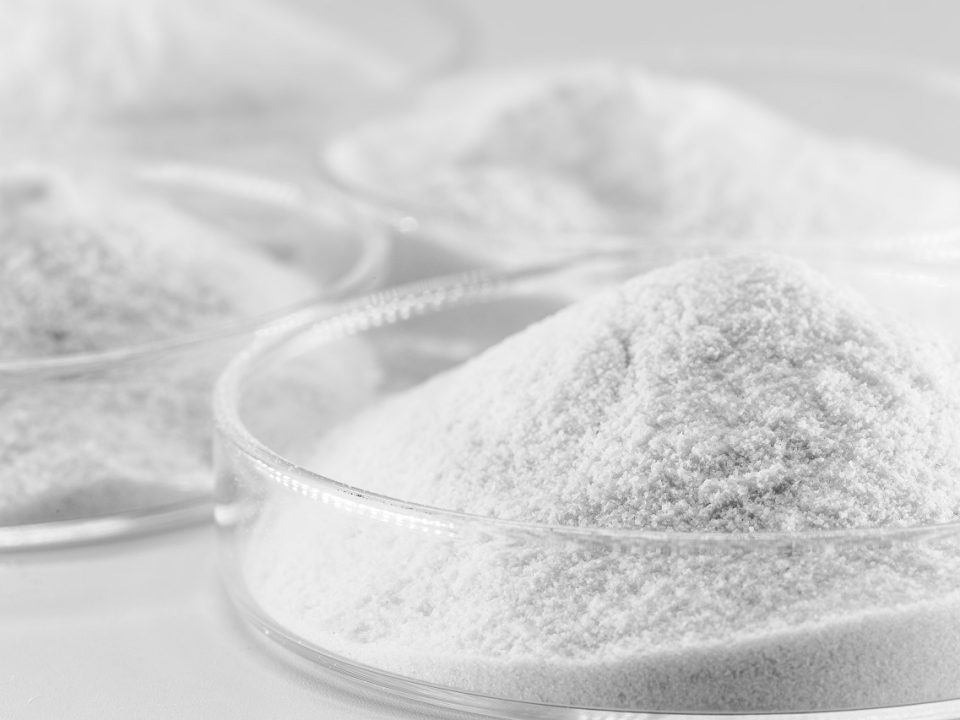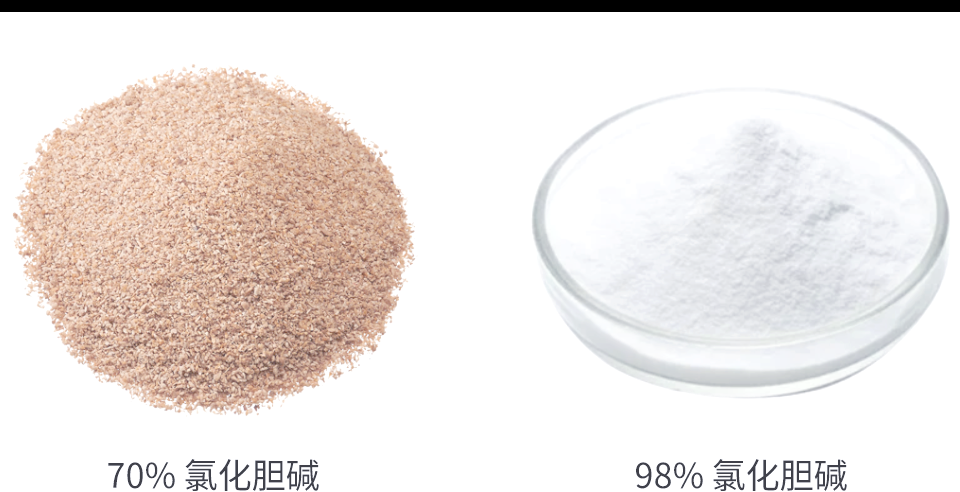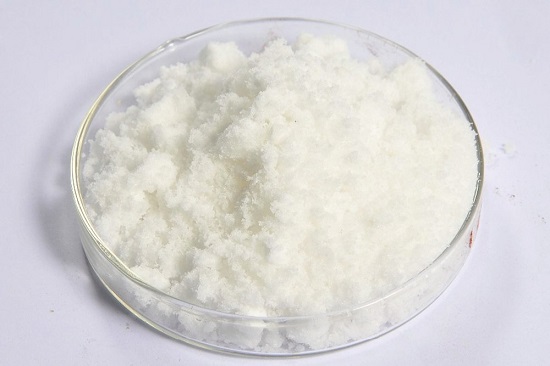Bubuk kolin klorida sebagai aditif pakan untuk hewan

Sertifikat analisis untuk bubuk tulang ayam
Mungkin 13, 2025
Makanan ayam untuk makanan anjing, Mengapa makanan ayam digunakan dalam makanan anjing
Juni 13, 2025Analisis komprehensif bubuk kolin klorida sebagai aditif pakan untuk hewan
Pengenalan
Kolin klorida bubuk, Suplemen nutrisi kritis dalam pakan ternak, Diakui secara luas karena perannya dalam mendukung kesehatan dan produktivitas berbagai spesies hewan, termasuk unggas, Babi, Ruminansia, spesies akuakultur, dan hewan pendamping. Diklasifikasikan sebagai vitamin B-kompleks (sering disebut vitamin b4), Kolin klorida adalah garam amonium kuaterner penting untuk berbagai fungsi fisiologis, seperti metabolisme lipid, Sintesis membran sel, dan produksi neurotransmitter. Kepentingannya berasal dari fakta bahwa banyak hewan, khususnya anak muda, tidak dapat mensintesis jumlah kolin yang memadai secara endogen, mengharuskan suplementasi makanan untuk mencegah kekurangan yang dapat mengganggu pertumbuhan, reproduksi, dan kesehatan secara keseluruhan.
Dalam nutrisi hewan, Kolin klorida dihargai karena kemampuannya untuk mencegah kondisi seperti sindrom hati berlemak, meningkatkan tingkat pertumbuhan, dan meningkatkan efisiensi konversi pakan. Bentuk bubuk, biasanya teradsorpsi ke pembawa seperti tongkol jagung, KULUT NAS, atau silika, lebih disukai karena kemudahan penggabungannya ke dalam formulasi pakan dan stabilitas selama penyimpanan. Tersedia dalam konsentrasi mulai dari 50% untuk 98%, Ini melayani berbagai kebutuhan di seluruh industri ternak dan akuakultur. Bagian ini mengeksplorasi peran multifaset dari kolin klorida, menggali signifikansi biokimia, aplikasi industri, dan alasan untuk penggunaannya yang luas.
Peran biokimia kolin klorida berakar pada kontribusinya terhadap sintesis fosfolipid, khususnya fosfatidilkolin, yang merupakan komponen kunci dari membran sel. Itu juga berfungsi sebagai pendahulu asetilkolin, Neurotransmitter yang kritis untuk fungsi saraf, dan bertindak sebagai donor kelompok metil, Mendukung proses metabolisme seperti sintesis metionin. Di unggas, misalnya, suplementasi kolin mencegah perosis (menyelinap tendon) dan meningkatkan produksi telur, saat dalam babi, Ini meningkatkan ukuran sampah dan kelangsungan hidup anak babi. untuk ruminansia, Ini mengurangi hati berlemak selama laktasi awal, dan dalam akuakultur, itu meningkatkan pertumbuhan dan kekebalan.
Permintaan global untuk kolin klorida telah melonjak karena praktik pertanian yang intensif dan kebutuhan untuk kinerja hewan yang dioptimalkan. Fleksibilitasnya meluas ke hewan pendamping, di mana ia mendukung fungsi kesehatan hati dan kognitif. namun, Tantangan seperti sifat higroskopis dan potensi untuk trimethylamine (TMA) Formasi membutuhkan penanganan dan formulasi yang cermat untuk memaksimalkan kemanjuran. Laporan ini bertujuan untuk memberikan analisis menyeluruh tentang bubuk kolin klorida, menutupi spesifikasinya, Komposisi kimia, Sifat material, Aplikasi, Dosis, Keselamatan, dan evaluasi ilmiah komparatif, memastikan pemahaman yang komprehensif tentang perannya dalam nutrisi hewan.
Produksi kolin klorida melibatkan reaksi asam klorida dengan trimethylamine dan ethylene oxide, menghasilkan produk sintetis yang hemat biaya. Sementara sumber alami seperti makanan kedelai menyediakan kolin, Konten variabel mereka membuat suplementasi dengan kolin sintetis klorida penting untuk nutrisi yang konsisten. Stabilitas bentuk bubuk dan kemudahan penggunaan menjadikannya bahan pokok di pabrik umpan, tetapi keterbatasannya, seperti korosivitas dan degradasi vitamin pada premix, memerlukan manajemen yang cermat. Pendahuluan ini menetapkan panggung untuk eksplorasi rinci spesifikasi dan aplikasi kolin klorida, menyoroti perannya yang sangat diperlukan dalam peternakan hewan modern.
Spesifikasi
Bubuk choline chloride adalah halus, Aditif pakan granular yang dirancang untuk dimasukkan ke dalam diet hewan, Menawarkan berbagai konsentrasi dan sifat fisik yang disesuaikan dengan aplikasi tertentu. Spesifikasinya mencakup bentuk fisik, konsentrasi, Pengemasan, persyaratan penyimpanan, dan standar kualitas, memastikan kesesuaiannya untuk kebutuhan nutrisi hewan yang beragam. Bagian ini memberikan tampilan mendalam tentang spesifikasi ini, menekankan pentingnya mereka dalam menjaga kemanjuran dan keamanan produk.
Bentuk dan penampilan fisik
Bentuk bubuk kolin klorida ditandai dengan penampilannya yang kekuningan atau kecokelatan, sering dipengaruhi oleh bahan pembawa yang digunakan, seperti tongkol jagung, Silika, atau bubuk sekam beras. Ini bagus untuk tekstur granular memastikan pencampuran yang seragam dalam pakan, Sedangkan bau yang sedikit mencurigakan, dikaitkan dengan jumlah trace trimethylamine (TMA), adalah karakteristik alami. Sifat higroskopis kolin klorida membutuhkan penanganan yang cermat untuk mencegah penyerapan kelembaban, yang dapat menyebabkan penggumpalan dan mengurangi umur simpan.
konsentrasi
Bubuk choline chloride tersedia dalam konsentrasi mulai dari 50% untuk 98%, dengan masing -masing tujuan tertentu:
-
50%: Biasa digunakan dalam pakan unggas dan babi, teradsorpsi ke tongkol jagung untuk efektivitas biaya.
-
60%: Opsi serbaguna untuk ternak dan akuakultur, menyeimbangkan kemanjuran dan keterjangkauan.
-
70%: Lebih disukai dalam premix untuk sapi babi dan susu, menawarkan potensi yang lebih tinggi.
-
98%: Formulir Kemurnian Tinggi yang Digunakan dalam Aplikasi Khusus, termasuk suplemen manusia dan nutrisi hewan peliharaan.
Konsentrasi mengacu pada kandungan kolin klorida, dengan kira -kira 25% dari berat molekul yang dikaitkan dengan klorida, artinya a 60% produk berisi tentang 45% kolin murni. Perbedaan ini sangat penting untuk dosis yang akurat dalam formulasi pakan.
Pengemasan dan Penyimpanan
Bubuk choline chloride biasanya dikemas 25 Kantong multi-layer kg dengan lapisan tahan air untuk melindungi dari kelembaban. Beberapa produsen menawarkan 1 Kantung KG atau opsi curah untuk operasi skala besar. Kondisi penyimpanan ketat karena higroskopisitas produk, membutuhkan keren, Kering, lingkungan yang berventilasi baik. Wadah tertutup sangat penting untuk menjaga stabilitas, dengan umur simpan yang khas 24 bulan saat disimpan dengan benar. Paparan panas atau kelembaban dapat mempercepat pembentukan TMA dan menurunkan kualitas produk.
baku mutu
Produsen mematuhi kontrol kualitas yang ketat untuk meminimalkan kotoran:
-
trimethylamine (TMA): Terbatas hingga ≤300 ppm untuk mencegah masalah bau dan potensi toksisitas.
-
Logam berat (PB): Terbatas pada ≤10 ppm untuk memastikan keamanan untuk hewan dan konsumen.
-
Kerugian pengeringan: ≤2% untuk menjaga stabilitas produk dan mencegah kue.
Standar -standar ini selaras dengan persyaratan peraturan di daerah seperti UE dan AS, memastikan penggunaan yang aman di pakan ternak. Pilihan operator (misalnya, Tongkol jagung vs.. Silika) mempengaruhi aliran dan stabilitas produk, dengan produk berbasis silika yang menawarkan kinerja yang unggul dalam kondisi lembab tetapi dengan biaya lebih tinggi.
Pertimbangan praktis
Spesifikasi bubuk kolin klorida secara langsung memengaruhi aplikasinya di pabrik umpan. misalnya, itu 60% Konsentrasi banyak digunakan karena keseimbangan biaya dan kemanjurannya, sedangkan 98% Formulir dicadangkan untuk aplikasi presisi tinggi. Sifat higroskopis bubuk memerlukan formulasi yang cermat untuk menghindari interaksi dengan komponen umpan lainnya, seperti vitamin, yang mungkin menurun di hadapannya. Bagian ini menggarisbawahi pentingnya memahami spesifikasi kolin klorida untuk mengoptimalkan penggunaannya dalam nutrisi hewan, menetapkan dasar untuk diskusi selanjutnya tentang sifat kimianya dan materialnya.
Komposisi kimia
Komposisi kimia bubuk kolin klorida adalah landasan fungsinya sebagai aditif pakan, mempengaruhi peran biologis dan stabilitas dalam formulasi pakan. Kolin klorida, secara kimia dikenal sebagai 2-hidroksietil-trimetil amonium klorida, adalah garam amonium kuaterner dengan formula molekul c₅h₁₄clno dan berat molekul dari 139.62 g/mol. Bagian ini menggali komposisinya, kotoran, dan implikasinya terhadap nutrisi hewan.
Komposisi unsur
Perkiraan kerusakan unsur kolin klorida murni adalah sebagai berikut:
|
Elemen |
Persentase |
|---|---|
|
Karbon (C) |
34.5% |
|
hidrogen (H) |
8.0% |
|
nitrogen (N) |
10.0% |
|
Oksigen (HAI) |
11.5% |
|
Klorin (Cl) |
25.5% |
Dalam bentuk bubuk komersial (misalnya, 50% atau 60% konsentrasi), Berat yang tersisa terdiri dari pembawa seperti tongkol jagung atau silika, yang menstabilkan produk dan memfasilitasi penanganan. Operator ini lembam dan tidak berkontribusi pada nilai gizi tetapi mempengaruhi sifat fisik produk, seperti kemampuan mengalir dan higroskopisitas.
Kelarutan dan reaktivitas
Kolin klorida sangat larut dalam air, membuatnya mudah secara hayati dalam sistem pencernaan hewan. Itu sedikit larut dalam etanol tetapi tidak larut dalam pelarut netral, yang memengaruhi penggabungannya ke dalam pakan. Reaktivitasnya meliputi pembentukan pelarut eutektik dalam dengan senyawa seperti urea atau gliserol, Properti yang dieksploitasi dalam beberapa aplikasi industri tetapi kurang relevan dalam pakan. namun, Sifat higroskopisnya dapat menyebabkan interaksi dengan komponen umpan lainnya, terutama vitamin, menyebabkan degradasi jika tidak dikelola dengan benar.
kotoran
Kontrol kualitas sangat penting untuk meminimalkan kotoran yang dapat mempengaruhi kesehatan hewan atau kualitas produk:
-
trimethylamine (TMA): Produk sampingan sintesis kolin klorida, TMA terbatas pada ≤300 ppm untuk menghindari bau amis dalam produk hewani seperti telur atau babi. TMA yang berlebihan juga dapat mengurangi ketersediaan hayati.
-
Logam berat: Lead dan logam berat lainnya dibatasi hingga ≤10 ppm untuk memastikan keamanan.
-
kadar air: Kehilangan pengeringan dijaga ≤2% untuk mencegah mencakup dan menjaga stabilitas.
Implikasi Biologis
Komposisi kimia menopang peran kolin klorida dalam metabolisme hewan. Komponen nitrogen dan karbon merupakan bagian integral dari fungsinya sebagai prekursor fosfatidilkolin dan asetilkolin. Ion klorida memastikan kelarutan dan stabilitas, Sedangkan bahan operator dalam produk konsentrasi rendah mengurangi biaya tetapi dapat mencairkan potensi. Kehadiran TMA, Bahkan pada level rendah, membutuhkan pemantauan yang cermat, seperti yang dapat dikonversi mikrobiota 66% kolin makanan ke dalam TMA, Mengurangi ketersediaan hayati dan berpotensi menyebabkan masalah bau.
Analisis komparatif
Dibandingkan dengan sumber kolin alami (misalnya, Bungkil kedelai), Sintetis choline chloride menawarkan komposisi yang konsisten tetapi bioavailabilitas yang lebih rendah karena konversi TMA. Bentuk alami, seperti phosphatidylcholine, lebih tersedia bioavail tetapi lebih mahal. Pilihan operator juga memengaruhi kinerja, dengan produk berbasis silika yang menawarkan stabilitas yang lebih baik dalam kondisi lembab dibandingkan dengan yang berbasis tongkol jagung. Bagian ini menyoroti pentingnya komposisi kimia dalam menentukan kemanjuran dan keamanan kolin klorida, membuka jalan untuk diskusi tentang sifat materialnya.
Sifat material
Sifat material bubuk kolin klorida, meliputi fisiknya, Kimia, dan karakteristik biologis, sangat penting untuk kinerjanya sebagai aditif umpan. Sifat -sifat ini mempengaruhi penanganannya, Stabilitas, dan kemanjuran nutrisi hewan, menjadikan mereka titik fokus bagi produsen dan petani pakan. Bagian ini mengeksplorasi properti ini secara rinci, memberikan wawasan tentang implikasi praktisnya.
Sifat fisik
Bubuk choline chloride adalah halus, bahan granular dengan penampilan coklat kekuningan atau kecokelatan, tergantung pada operator (misalnya, tongkol jagung, Silika). Bau itu sedikit mencurigakan, disebabkan oleh residu TMA, adalah fitur yang membedakan. Higroskopisitas bubuk adalah tantangan yang signifikan, karena mudah menyerap kelembaban, mengarah ke penggumpalan dan potensi degradasi komponen pakan lainnya. Ukuran partikel bervariasi dari halus ke granular, Memastikan distribusi yang seragam dalam pakan tetapi membutuhkan penyimpanan yang cermat untuk menjaga kemampuan mengalir.
Sifat kimia
Secara kimiawi, kolin klorida stabil dalam kondisi normal tetapi dapat menurunkan vitamin a, D, dan k dalam premix karena sifatnya yang higroskopis dan sedikit korosif. Degradasi ini diperburuk di hadapan elemen logam, memerlukan formulasi yang cermat. Kelarutan airnya yang tinggi meningkatkan ketersediaan hayati tetapi juga berkontribusi pada higroskopisnya, membutuhkan penyimpanan yang disegel. Reaktivitas kolin klorida dengan senyawa seperti urea atau gliserol kurang relevan dalam pakan tetapi menyoroti keserbagunaan kimianya.
Sifat biologis
Secara biologis, kolin klorida adalah nutrisi kritis:
-
Metabolisme Lipid: Mencegah sindrom hati berlemak dengan mempromosikan sintesis fosfolipid, khususnya fosfatidilkolin, yang memfasilitasi transportasi lemak.
-
Sintesis neurotransmitter: Berfungsi sebagai pendahulu asetilkolin, mendukung fungsi saraf dan koordinasi.
-
Integritas membran sel: Berkontribusi terhadap fosfatidilkolin, Komponen kunci membran sel.
-
Donasi kelompok metil: Bertindak sebagai donor metil, menghemat metionin dan proses metabolisme pendukung.
Sifat -sifat ini membuat kolin klorida sangat diperlukan untuk hewan muda dan yang di bawah stres metabolik tinggi, seperti sapi menyusui atau ayam pedaging yang tumbuh dengan cepat.
Implikasi praktis
Sifat higroskopis kolin klorida membutuhkan penyimpanan kering dan formulasi yang cermat untuk mencegah interaksi dengan komponen umpan lainnya. Korosivitasnya, khususnya dalam bentuk cair, dapat merusak peralatan, memerlukan stainless steel atau mesin yang dilapisi. Sifat biologis memastikan kemanjurannya di seluruh spesies, Tetapi potensi pembentukan TMA mengurangi ketersediaan hayati, membutuhkan dosis yang tepat untuk menghindari limbah. Operator berbasis silika meningkatkan stabilitas dibandingkan dengan tongkol jagung, Tetapi biaya yang lebih tinggi dapat membatasi penggunaan dalam operasi yang sadar anggaran.
Analisis komparatif
Dibandingkan dengan cair choline chloride, Bentuk bubuk lebih mudah ditangani dan disimpan tetapi kurang fleksibel dalam aplikasi tertentu, seperti suplemen air minum. Sumber kolin alami, seperti makanan kedelai, menawarkan konten kolin variabel, menjadikan kolin sintetis klorida pilihan yang lebih dapat diandalkan untuk nutrisi yang konsisten. Bagian ini menggarisbawahi pentingnya memahami sifat material kolin klorida untuk mengoptimalkan penggunaannya dalam pakan, mengatur tahap untuk penerapannya dalam nutrisi hewan.
Aplikasi dalam Nutrisi Hewan
Bubuk choline chloride adalah aditif pakan serbaguna dengan aplikasi di seluruh unggas, Babi, Ruminansia, budidaya, dan hewan pendamping. Perannya dalam mendukung pertumbuhan, kesehatan, dan produktivitas menjadikannya landasan nutrisi hewan modern. Bagian ini mengeksplorasi aplikasinya, menyoroti manfaat spesifik spesies dan gejala kekurangan.
Unggas
Di unggas, kolin klorida meningkatkan pertumbuhan, efisiensi pakan, dan produksi telur. Untuk ayam pedaging, Suplementasi pada 600-1200 g/ton pakan meningkatkan kenaikan berat badan dan mencegah perosis dan sindrom hati berlemak. Berlapis -lapis, itu mendukung produksi telur, Kualitas kulit telur, dan formasi kuning telur, dengan asupan yang direkomendasikan 105 mg/hari untuk putih telur dan lapisan 115 mg/hari untuk lapisan telur coklat. Gejala kekurangan termasuk berkurangnya pertumbuhan, perosis, dan kemampuan menetas yang buruk.
Babi
Untuk babi, kolin klorida meningkatkan kelangsungan hidup anak babi dan menabur kesuburan. Dosis 600–1300 g/ton mendukung metabolisme lipid dan pertumbuhan anak babi, saat ditabur, Ini meningkatkan ukuran serasah dan kesehatan reproduksi. Gejala kekurangan termasuk pertumbuhan yang lebih lambat, gangguan perilaku, dan hati berlemak.
Ruminansia
Pada sapi perah, Kolin klorida (500–1000 g/ton) mencegah hati berlemak selama laktasi awal dan meningkatkan produksi susu. Pada sapi daging sapi, Ini mendukung penambahan berat badan dan mengurangi deposisi lemak. Gejala kekurangan termasuk masalah pernapasan, Mengurangi nafsu makan, dan pertumbuhan yang lebih lambat.
budidaya
Dalam ikan dan udang, Kolin klorida (800–3000 g/ton) mempromosikan pertumbuhan, meningkatkan efisiensi pakan, dan meningkatkan kekebalan dalam sistem intensif. Gejala kekurangan termasuk hati berlemak, Pendarahan ginjal, dan pertumbuhan yang buruk.
Hewan peliharaan
Pada anjing dan kucing, kolin klorida mendukung kesehatan hati dan fungsi kognitif, khususnya dalam kasus kejang atau disfungsi kognitif. Gejala defisiensi termasuk disfungsi hati dan berkurangnya nafsu makan.
Pertimbangan praktis
Kemanjuran kolin klorida tergantung pada komposisi umpan, sebagai sumber alami seperti makanan kedelai memberikan kadar kolin variabel. Efek hemat metioninnya mengurangi biaya diet, Tetapi penawaran berlebihan harus dihindari untuk mencegah masalah bau terkait TMA. Bagian ini menyoroti penerapan luas kolin klorida, menekankan perannya dalam mengoptimalkan kesehatan dan produktivitas hewan.
Rekomendasi Dosis
Dosis bubuk kolin klorida yang tepat sangat penting untuk memaksimalkan manfaatnya sambil menghindari limbah atau efek samping. Dosis bervariasi berdasarkan spesies, usia, tahap produksi, dan komposisi umpan. Bagian ini memberikan rekomendasi terperinci, didukung oleh meja dan pertimbangan praktis.
Tabel dosis (60% konsentrasi)
|
Spesies |
Dosis (g/ton pakan) |
Catatan |
|---|---|---|
|
Ayam pedaging |
600–1200 |
Dosis yang lebih tinggi untuk diet starter; Sesuaikan berdasarkan kandungan kolin alami. |
|
Lapisan |
500–1000 |
Mendukung produksi telur; 500 G/ton cukup untuk pemeliharaan. |
|
Babi |
600–1300 |
Dosis yang lebih tinggi untuk anak babi dan menabur untuk mendukung pertumbuhan dan reproduksi. |
|
Sapi perah |
500–1000 |
Mencegah hati berlemak selama laktasi awal. |
|
ikan |
800–2000 |
Dosis yang lebih tinggi untuk sistem intensif untuk mendukung pertumbuhan dan kekebalan. |
|
udang |
1000–3000 |
Meningkatkan pertumbuhan dan kelangsungan hidup dalam akuakultur dengan kepadatan tinggi. |
Faktor -faktor yang mempengaruhi dosis
-
Kandungan kolin alami: Bahan seperti makanan kedelai (2500–3000 mg/kg kolin) mengurangi kebutuhan suplementasi.
-
tahap produksi: Tumbuh hewan dan betina menyusui membutuhkan dosis yang lebih tinggi.
-
Pemrosesan pakan: Pelet atau ekstrusi dapat mengurangi ketersediaan hayati kolin, mengharuskan tingkat inklusi yang lebih tinggi.
Pertimbangan praktis
Penegangan berlebihan (>2000 mg/kg dalam unggas) tidak memberikan manfaat tambahan dan dapat meningkatkan produksi TMA, mengarah ke masalah bau. Efek penghargaan metionin memungkinkan untuk mengurangi inklusi metionin, menurunkan biaya pakan. Formulasi yang cermat diperlukan untuk menghindari interaksi dengan vitamin, dan operator berbasis silika dapat meningkatkan stabilitas di lingkungan kelembaban tinggi. Bagian ini memberikan panduan komprehensif untuk dosis, memastikan penggunaan kolin klorida yang optimal dalam nutrisi hewan.
Keamanan dan penanganan
Keamanan dan penanganan bubuk kolin klorida sangat penting untuk penggunaannya yang efektif dalam pakan ternak. Bagian ini mencakup keamanan untuk hewan, manusia, dan lingkungan, bersama dengan pertimbangan penanganan untuk mempertahankan kualitas produk.
Keamanan untuk hewan
Kolin klorida aman pada dosis yang disarankan, dengan sedikit keselamatan di unggas dan babi. Overdosis harus dihindari, khususnya saat digunakan dalam air pakan dan minum. Produksi TMA yang berlebihan (>300 PPM) dapat menyebabkan bau mencurigakan pada produk hewani, mempengaruhi marketabilitas. Risiko kekurangan termasuk hati berlemak, mengurangi pertumbuhan, dan masalah reproduksi.
Keamanan untuk manusia
Kolin klorida tidak menimbulkan risiko yang signifikan bagi konsumen, karena dimetabolisme oleh hewan dan tidak menumpuk dalam jaringan. Untuk pekerja, risiko inhalasi rendah, karena partikel tidak mungkin mencapai alveoli. Solusi berair (Hingga 70%) tidak iritasi, Tetapi bentuk padat dapat menyebabkan kepekaan kulit pada individu yang sensitif.
Dampak Lingkungan
Penggunaan kolin klorida dalam pakan memiliki dampak lingkungan minimal, karena tidak secara signifikan meningkatkan konsentrasi tanah atau air. Pembuangan produk yang tidak digunakan yang tepat disarankan untuk mencegah kontaminasi lokal.
Menangani pertimbangan
Higroskopisitas bubuk membutuhkan penyimpanan tertutup untuk mencegah penggumpalan dan degradasi vitamin. Korosivitasnya, khususnya dalam bentuk cair, mengharuskan peralatan yang sesuai. Kontrol kualitas memastikan tingkat TMA dan logam berat yang rendah, menjaga keamanan dan kemanjuran. Bagian ini menggarisbawahi pentingnya penanganan yang tepat untuk memaksimalkan manfaat kolin klorida sambil meminimalkan risiko.
Analisis dan perbandingan ilmiah
Bagian ini memberikan evaluasi ilmiah kemanjuran kolin klorida, membandingkannya dengan sumber kolin alternatif dan menganalisis tantangan dan manfaatnya.
Kemanjuran nutrisi hewan
Penelitian menunjukkan efektivitas kolin klorida:
-
Unggas: Emmert dan Baker (1997) menemukan pertumbuhan optimal di broiler di 800 mg/kg, dengan konversi pakan yang lebih baik.
-
Babi: Dosis 600–1300 g/ton meningkatkan kelangsungan hidup anak babi dan menabur kesuburan.
-
budidaya: 1000–3000 g/ton meningkatkan pertumbuhan dan kekebalan udang.
Sintetis vs.. Kolin alami
-
Kolin sintetis klorida: Hemat biaya tetapi rentan terhadap konversi TMA (Hingga 66% kehilangan).
-
Kolin alami (misalnya, Natu-B4™): Lebih tersedia secara hayati, tahan panas, dan bebas TMA tapi lebih mahal.
Alternatif
-
fosfatidilkolin: Menawarkan potensi dan stabilitas yang lebih tinggi tetapi membutuhkan dosis yang lebih rendah.
-
Betaine: Bertindak sebagai donor metil tetapi tidak memiliki peran neurotransmitter kolin.
Tantangan
-
Higroskopisitas: Menyebabkan degradasi penggumpalan dan vitamin.
-
Formasi TMA: Mengurangi ketersediaan hayati dan menyebabkan masalah bau.
-
Interaksi vitamin: Mempercepat degradasi vitamin a, D, dan k.
Tabel komparatif
|
PARAMETER |
Kolin klorida (60%) |
fosfatidilkolin |
Betaine |
|---|---|---|---|
|
Biaya |
rendah |
tinggi |
Sedang |
|
ketersediaan hayati |
Sedang |
tinggi |
tinggi (donor metil saja) |
|
Higroskopisitas |
tinggi |
rendah |
rendah |
|
Formasi TMA |
tinggi |
Tidak ada |
Tidak ada |
Bagian ini menyoroti kemanjuran dan tantangan Choline Chloride, memberikan dasar ilmiah untuk penggunaan dan perbandingannya dengan alternatif.
Kesimpulan
Bubuk kolin klorida adalah aditif pakan vital, mendukung kesehatan dan produktivitas hewan di seluruh spesies. Perannya dalam metabolisme lipid, Sintesis neurotransmitter, dan donasi metil membuatnya sangat diperlukan, khususnya untuk hewan muda atau tinggi. Sementara higroskopisitas dan pembentukan TMA menimbulkan tantangan, Penanganan dan formulasi yang tepat dapat mengurangi masalah ini. Alternatif seperti fosfatidilkolin menawarkan keuntungan tetapi dengan biaya lebih tinggi. Dengan mematuhi dosis dan praktik penyimpanan yang direkomendasikan, Petani dapat mengoptimalkan manfaat choline chloride, memastikan nutrisi hewan yang berkelanjutan dan efisien.






